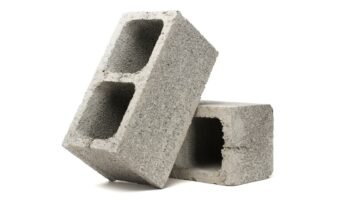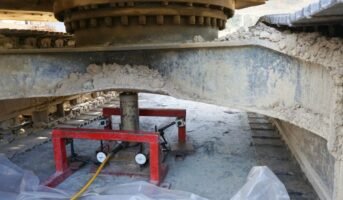The development of concrete for a wide range of construction purposes relies on the formulation of a concrete mixture with aggregates in a precise ratio. Adding the proper quantity of aggregates to the cement mix allows for the construction of strong concrete structures. It is essential to make sure that each of the components is used appropriately, both in terms of the proportions involved and the manner in which they are employed.
In this article, we will discuss the M15 cement mix ratio, as well as its applications and comparisons to other cement mix ratios
See also: Types of concrete
M15 ratio: What is it?

Source: Pinterest
The M15 ratio refers to the relative amounts of individual concrete ingredients such as sand, aggregates, cement, and water. The proportions of each component are determined by the building method and mixed layout. Concrete that meets the requirements of an M15 grade is considered an average grade. It is quite similar to M10 in terms of its characteristics, qualities, and applications, with just a minute degree of differentiation between the two.
see also about ingredients in cement
M15 ratio: Different components in the M15 ratio

Source: Pinterest
When trying to determine what amounts of concrete mix are optimal for a certain scenario, having a solid understanding of the roles that each component plays is essential. Four major ingredients of the M15 ratio include:
-
Cement
Cement is a binding material whose main component is calcium oxide. Limestone, when subjected to extreme heat, yields calcium oxide. Secondary components, including silicon, iron, and others, may be found in cement as well.
-
Aggregate
Aggregate, which consists of washed and crushed rock and is sometimes referred to as “gravel,” is the component that provides M15 grade concrete its compressive strength.
-
Sand
Sand is an excellent filling ingredient because it reduces air pockets and gaps between the individual pulverised rock pieces, and it also has a relatively high compressive strength.
-
Water
The chemical reaction between the water and the quicklime in cement is what causes the cement to adhere to rocks and sand, and it is also what makes concrete workable.
See also: Types of building materials
M15 ratio: Type of concrete mix ratio
According to IS Code 456-2000, there are three distinct kinds of concrete mix ratio, each of which finds its own use for a certain type of construction project.
-
Nominal Concrete Mix Ratios
Concrete mixes with a nominal volume provide simplicity and, under typical conditions, have a durability margin that is more than that stated for the mix. On the other hand, given the same level of workability, the nominal strength of the concrete might range quite a little depending on the elements in the mix.
For example, the M15 ratio of concrete is 1:2:4, where 1 refers to the number of cement particles, 2 to the number of sand particles, and 4 to the number of aggregate particles. The nominal mix ratio for different cement grades is represented in the following table.
| Concrete Grade | Mix Ratio | Compressive Strength | |
| M5 | 1 : 5 : 10 | 5 MPa | 725 psi |
| M7.5 | 1 : 4 : 8 | 7.5 MPa | 1087 psi |
| M10 | 1 : 3 : 6 | 10 MPa | 1450 psi |
| M15 | 1 : 2 : 4 | 15 MPa | 2175 psi |
| M20 | 1 : 1.5 : 3 | 20 MPa | 2900 psi |
-
Standard Mixes Ratio
The strength of standard mixes is often higher than advertised, and they are easy to use. As a rule, this ratio is used for projects of a modest magnitude. The relative amounts of each concrete element and the statutory concrete mix ratios are set in stone for this mixture type. The standard mix ratio for different cement grades is represented in the following table.
| Concrete Grade | Mix Ratio | Compressive Strength | |
| M25 | 01:01:02 | 25 MPa | 3625 psi |
| M30 | Design Mix | 30 MPa | 4350 psi |
| M35 | Design Mix | 35 MPa | 5075 psi |
| M40 | Design Mix | 40 MPa | 5800 psi |
| M45 | Design Mix | 45 MPa | 6525 psi |
-
High Strength Concrete Mix Ratio
High Strength mixtures simplify things and, in most cases, have more strength than is required. In most cases, the High Strength mix ratio will be used for the construction of smaller-scale buildings. The statutory concrete mix proportions and the concrete ingredient percentages are prefixed and stated in this sort of mix. The high strength mix ratio for different cement grades is represented in the following table.
| Concrete Grade | Mix Ratio | Compressive Strength | |
| M50 | Design Mix | 50 MPa | 7250 psi |
| M55 | Design Mix | 55 MPa | 7975 psi |
| M60 | Design Mix | 60 MPa | 8700 psi |
| M65 | Design Mix | 65 MPa | 9425 psi |
| M70 | Design Mix | 70 MPa | 10150 psi |
M15 ratio: M15 grade concrete applications
- PCC stands for plain cement concrete, which is what M15 concrete is used for.
- The M15 grade is employed for pavers in the building.
- It is also an excellent choice for floor binding.
- A levelling course may be constructed using M15-grade concrete as a building material.
- Concrete of grade M15 is suitable for use in the construction of concrete roadways.
- Because it has such tremendous strength, the M15 grade is extremely relevant and helpful for the construction of high-rise structures.
- During the building process, it is used in plain concrete that’s been poured into the process of creating levels to produce beddings for footing.
- If you want to prevent moisture from seeping into the ground and raise the level at the same time, you should insulate the area with a layer of M15 and put down a barrier layer of sheets.
FAQs
Why is it necessary to produce an appropriate M15 cement mix?
If you can get the cement mixture to the correct consistency, you can apply it to the surfaces with ease.
Why is it advised to prepare a lesser quantity of M15 cement mixture?
The amount required is determined by the scope of the job. It is advised that you use a smaller quantity in order to prevent the cement mix from drying out while it is being applied.
What is the optimal mix ratio for cement?
All types of concrete used for various building applications should employ a cement mix ratio of 4:2:1, as recommended by experts. That's right, if you want the perfect cement mix for preparing concrete, all you need is 4 parts crushed stones, 2 parts sand, and 1 part cement. In construction, the cement used for various tasks will be different. This proportion, however, is seen as typical.
Housing News Desk is the news desk of leading online real estate portal, Housing.com. Housing News Desk focuses on a variety of topics such as real estate laws, taxes, current news, property trends, home loans, rentals, décor, green homes, home improvement, etc. The main objective of the news desk, is to cover the real estate sector from the perspective of providing information that is useful to the end-user.
Facebook: https://www.facebook.com/housing.com/
Twitter: https://twitter.com/Housing
Email: editor@housing.com












